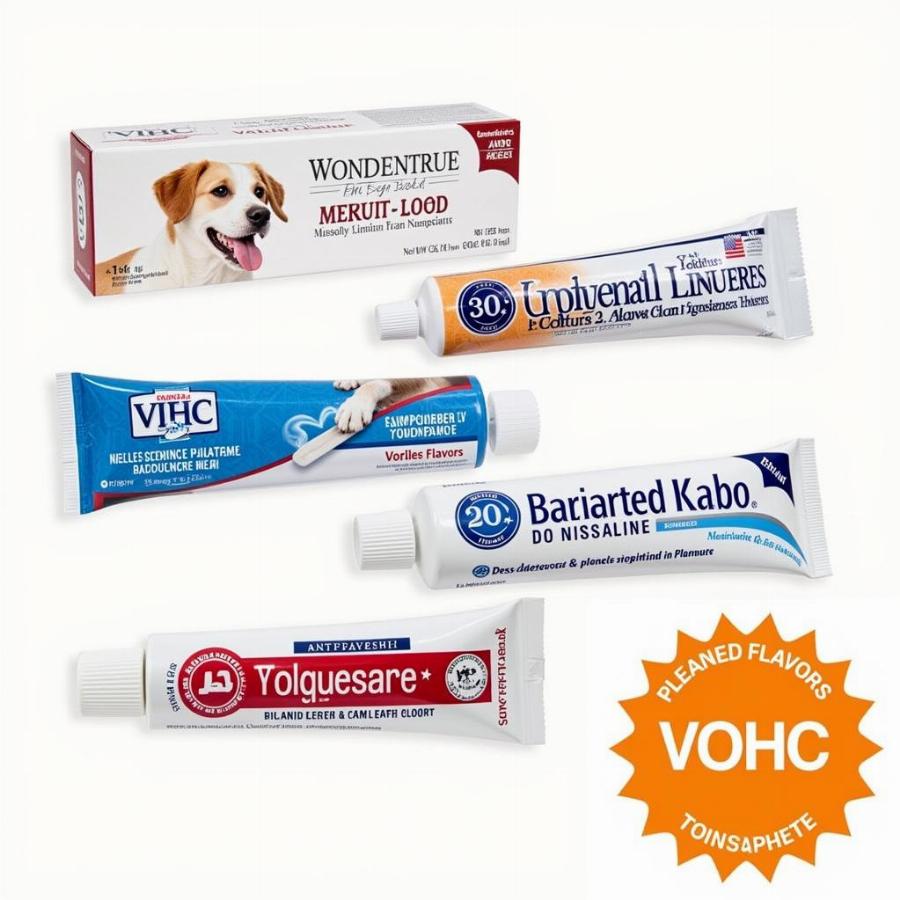Human toothpaste is formulated for humans, not our furry friends. While we might think a quick dab of our minty fresh paste could help our dog’s breath, the truth is human toothpaste can actually be harmful to dogs. This is due to ingredients like xylitol, an artificial sweetener that’s toxic to dogs, and fluoride, which can cause digestive upset in large amounts. So, before you reach for your own toothpaste, let’s explore the world of canine dental hygiene and learn how to best care for your dog’s pearly whites.
Why Human Toothpaste is a No-Go for Dogs
The key ingredient that makes human toothpaste dangerous for dogs is xylitol. This sugar substitute is commonly found in sugar-free gums, candies, and toothpaste. Even small amounts of xylitol can cause a rapid drop in blood sugar (hypoglycemia) in dogs, leading to weakness, tremors, seizures, and even liver failure. Fluoride, while beneficial for humans in preventing cavities, can also be harmful to dogs if ingested in large quantities. Over time, excessive fluoride intake can lead to dental fluorosis, causing discoloration and weakening of the teeth. Additionally, the foaming agents and strong flavors in human toothpaste are not designed for canine consumption and can cause digestive upset, vomiting, and diarrhea.
Choosing the Right Toothpaste for Your Dog
So, what can you use to clean your dog’s teeth? The answer is simple: dog toothpaste! Dog toothpaste is specifically formulated with ingredients that are safe for canine consumption. These toothpastes come in a variety of flavors that dogs love, such as poultry, beef, and peanut butter, making the teeth-brushing experience more enjoyable for both you and your pup. Look for dog toothpastes that carry the Veterinary Oral Health Council (VOHC) seal of approval, as this indicates the product has met pre-set standards of safety and efficacy.
 Dog Toothpaste Options
Dog Toothpaste Options
Establishing a Dental Routine for Your Dog
Just like humans, dogs need regular dental care to prevent plaque buildup, tartar, gum disease, and other oral health issues. Ideally, you should brush your dog’s teeth daily. However, even brushing a few times a week can make a significant difference. Start by introducing the toothbrush and toothpaste gradually, allowing your dog to lick and sniff them. Use positive reinforcement, such as praise and treats, to make the experience positive. For a step-by-step guide on how to brush your dog’s teeth, check out our article on dog baths and beyond. Similar to dog tartar removal, regular brushing is essential.
Can I use a human toothbrush on my dog?
While you can technically use a human toothbrush on your dog, it’s generally recommended to use a toothbrush specifically designed for dogs. Dog toothbrushes often have softer bristles and are angled to better reach all areas of a dog’s mouth. You can also find finger brushes, which are small, silicone brushes that fit over your fingertip, making them a good option for smaller dogs or those who are resistant to traditional toothbrushes.
Beyond Brushing: Other Dental Care Options
Brushing is the cornerstone of canine dental care, but there are other ways to support your dog’s oral health. Dental chews, treats, and toys can help to mechanically scrape away plaque and tartar. Look for products that have the VOHC seal. You can also consider adding dental rinses or water additives to your dog’s routine. If you’re concerned about your dog’s dental health, it’s essential to schedule regular checkups with your veterinarian. They can perform professional cleanings and address any potential issues. You might also find our article on can a tooth abscess kill a dog informative.
Conclusion
Can dogs use human toothpaste? The answer is a resounding no. Human toothpaste contains ingredients that are harmful to dogs, such as xylitol and excessive fluoride. Instead, opt for dog toothpaste formulated specifically for their needs. Establishing a regular dental routine, including brushing and using other dental care products, will help keep your dog’s teeth and gums healthy for years to come. Remember, a healthy mouth contributes to a happy dog! For those interested in the benefits of enzymes, our article on dog toothpaste with enzymes offers more insights. Can I use toothpaste on my dog? Only if it’s specifically designed for canine use!
FAQ
- What are the signs of xylitol poisoning in dogs? Signs include weakness, vomiting, tremors, seizures, and liver failure.
- How often should I brush my dog’s teeth? Ideally, daily. However, a few times a week is still beneficial.
- What kind of toothbrush should I use for my dog? A toothbrush designed for dogs, or a finger brush.
- Are there any alternatives to brushing my dog’s teeth? Dental chews, treats, toys, rinses, and water additives.
- How can I make teeth brushing more enjoyable for my dog? Use positive reinforcement, such as praise and treats.
- What is the VOHC seal? It indicates a product has met standards of safety and efficacy for oral health.
- Why is dog dental care important? It prevents plaque, tartar, gum disease, and other oral health issues.
Beaut Dogs is your one-stop resource for all things related to show dogs, offering expert advice and guidance on every aspect of dog ownership. From breed selection to comprehensive care guides, we are dedicated to providing valuable and reliable information to the dog-loving community. When you need support, contact us at Email: [email protected] to get detailed and accurate answers from Beaut Dogs. Visit https://beautdogs.com today to explore the wonderful world of show dogs and discover how to care for them best!